Dance with the Devil: The Joker in Cinema
A look into The Joker's impact on cinema history.
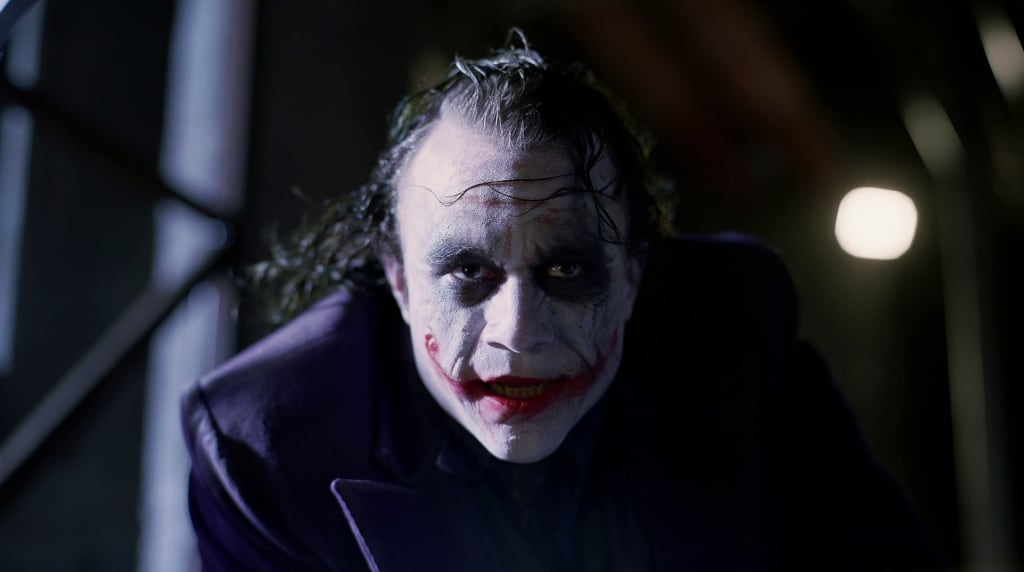
Every few decades, something very unique happens: An audience sits down in a movie theater, the movie screen illuminates and the audience is swept away. The energy of the auditorium changes and everyone realizes they are watching something special. This happened when audiences were introduced to Darth Vader. It happened again two decades later when Clarice Starling walked into that dungeon, down the corridor, and was greeted by Dr. Hannibal Lecter. And it happened in 2008 when this masked figure robbed a bank in Gotham City. The Joker arrived. He’d been in live-action movies before but this time something was different; something we could not articulate. Cinema had changed.
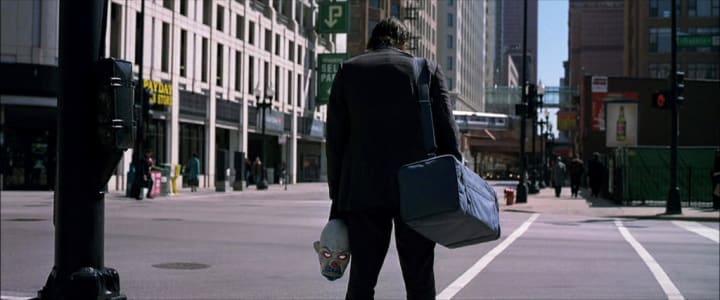
The Dark Knight was the highest-grossing film of 2008. Almost 20 years before that, Batman was released and was the second highest-grossing film of 1989. Fast forward back to 2016, Suicide Squad was also one of the highest-grossing films of the year. Three years later, Joker is released and grosses $1 billion at the box office; becoming the highest-grossing R-rated film of all time.
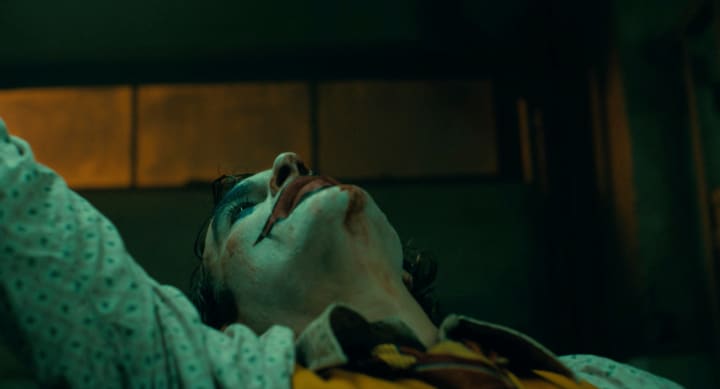
The Joker has certainly made his stamp on the entertainment industry. The role has been pursued by the biggest movie stars and character actors. Since 1989, The Joker has been portrayed by the best actors of their era. In fact, each actor that has played The Joker has something in common: They are all Academy Award winners. Jack Nicholson had two Oscars and an insane amount of nominations before the film was released (He would go on to win one more). Jared Leto had won an Oscar for Best Supporting Actor just three years before. And Heath Ledger and Joaquin Phoenix both won Academy Awards for their portrayals of the character in their respective films.

The Joker first appeared in the first issue of Batman’s solo comic book series. Since then, he has become Batman’s archenemy; the first villain that comes to mind when someone mentions Batman. This is quite an accomplishment considering the fact Batman has some of the most iconic villains in pop culture. Everyone has a fascination with Catwoman, Two-Face, and The Riddler, but there’s something about this psychotic clown that captures people’s imagination, making him one of the most adaptable pop culture villains in the past 80 years.

Joker the Movie Star
The creation of The Joker has a lot in common with his fictional origins: There is a lot of ambiguity and contradiction. Bob Kane, the creator of Batman, refused to give his collaborators credit for creating characters (Most famously Batman co-creator, Bill Finger, who introduced a lot of aspects of Batman that are now staples of pop culture.) In 1940, The Joker was created by three people: Bill Finger, Bob Kane, and his assistant, Jerry Robinson. On the creation of The Joker, Robinson said, “I felt that Batman needed a supreme arch-villain to test him…Batman didn’t need another crime lord like Al Capone. I felt he needed something more exotic…the strip needed an antagonist that would be more enduring; a continuing conflict in the literary tradition of Holmes and Moriarty or King Arthur and Mordred…[the Joker] was a diabolically sinister villain and yet had a clownish aspect. I found the idea of a sinister clown utterly fascinating.”
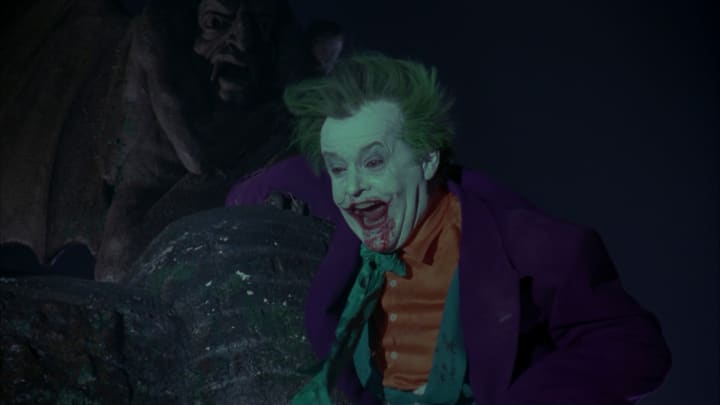
It was the 80s where The Joker reached his final form. DC Comics published three definitive Batman/Joker stories. Alan Moore’s The Killing Joke, which revealed a possible “origin” where he was a standup comedian who donned the Red Hood criminal alias to support his family and fell into a vat of chemicals. Years later, The Joker wants to prove even the most decent man will abandon his morals after having “one bad day.” He kidnaps Batman’s ally, Commissioner Gordon, and shoots his daughter, Barbara Gordon, who fights crime as Batgirl. In A Death in the Family, The Joker murders Batman’s sidekick, Robin. Frank Miller’s The Dark Knight Returns explores the symbiotic relationship between Batman and The Joker. When Batman returns to crime-fighting after a ten-year absence he reawakens The Joker, a catatonic mental patient.
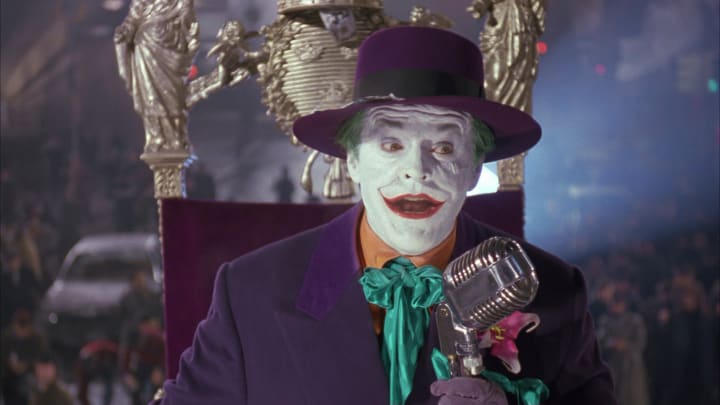
Now that The Joker’s legendary comic book status had been established, Warner Bros. wanted a movie star to play him in Tim Burton’s Batman, released in 1989. They considered Tim Curry, (who probably would have been better here than in the tv adaptation of Stephen King’s It.) David Bowie, James Woods, and Ray Liotta. John Lithgow auditioned but convinced Tim Burton to not cast him; a decision he later regretted. Robin Williams campaigned hard but they went with their first choice, Jack Nicholson, who at that point had already been carved into the Mt. Rushmore of actors. His performance as The Joker was praised by critics and fans, influencing every Joker performance from live-action to animation.
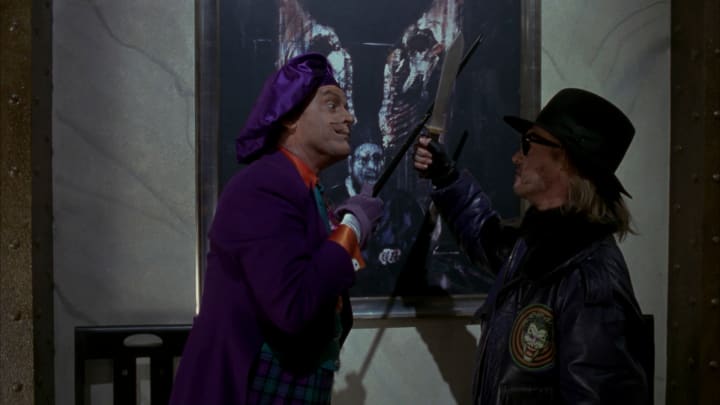
The film changes The Joker’s origins. He’s Jack Napier, the psychotic number two to Gotham’s more notorious crime boss, Carl Grissom. He’s having an affair with Grissom’s girlfriend. When Grissom discovers this, he alerts the cops when he asks Jack to pull off a job at the chemical plant. When the cops and Batman arrive, a shootout ensues and Batman tries to save him before he falls into a vat of chemicals.
Napier, now disfigured, returns and murders Grissom, takes over Gotham’s criminal underworld and stalks Vicky Vale. He considers himself an artist and obsesses over taking Batman’s place in the headlines. In this film, Jack Napier murdered Bruce’s parents when he was a young hood. Bruce discovers this when he first meets The Joker at Vicky Vale’s apartment. Bruce starts swinging around a fire poker and madly yelling “YOU WANNA GET NUTS?!” (The insanity of this scene is FUCKING BAFFLING.) The Joker pulls out a pistol and asks “Have you ever danced with the Devil in the pale moonlight,” something that Napier says to people before he shoots someone; something Bruce witnessed him say to his parents before they were shot down when he was a child.

This deviation from the comics adds a new layer to Batman and Joker’s relationship; as if the two were destined to meet each other when they became their true selves: Two costumed freaks, one a creature of terror, the other a symbol of joy and laughter, battling for Gotham’s soul.
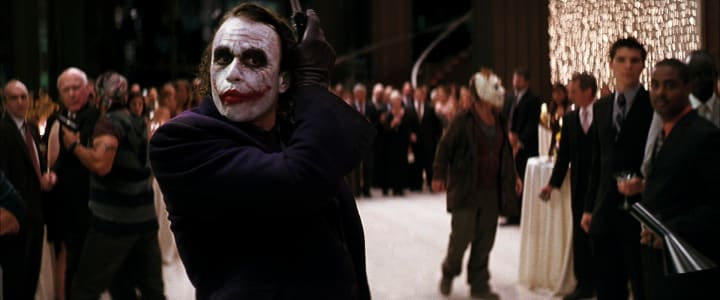
Joker the Anarchist
On January 22, 2008, Heath Ledger was found dead in his SoHo apartment. He was filming Terry Gilliam’s The Imaginarium of Doctor Parnassus, where he frequently commented on his insomnia and his use of prescription medication to help him sleep. His lack of sleep heavily affected his health and caused him respiratory illness. The toxicology report showed that Ledger died from an accidental overdose of pills usually prescribed for insomnia, anxiety, and cold symptoms. He never completed filming The Imaginarium of Doctor Parnassus; leaving The Joker Ledger’s last completed role.
Ledger’s death has now become the stuff of Hollywood legend; a talented actor whose death was caused by his intense method acting. Ledger prepped for the role by staying alone in a hotel room where he read comic books for research, created a diary for the character, and experimented with voices and physicality to distinguish himself from Jack Nicholson’s iconic performance. The public perception is the intensity of playing The Joker, a character so disturbed, took a toll on Ledger’s mental health, causing his insomnia which led to his death. This is not true. Not even a little bit.
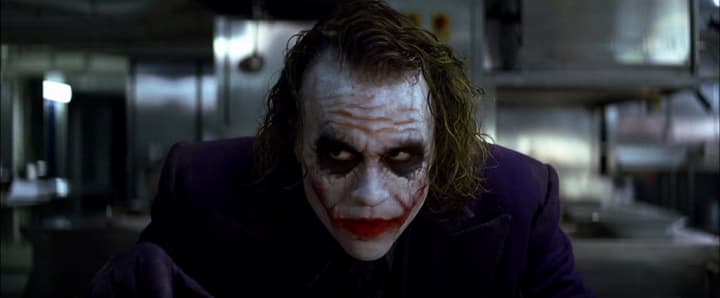
When the cameras cut, Ledger would just be himself; smoking cigarettes and goofing around skateboarding in full costume. Ledger’s make-up artist, John Caglione, said he would help others relax “never letting the intensity of the roles overwhelm him. And no matter how banged-up or bruised Heath was after a long day, after we’d take off the last drop of makeup, he’d just hug everybody in the trailer before he left.” Ledger was looking for something a little out there; something as odd as Johnny Depp’s Jack Sparrow. Ledger said, “I feel like this is an opportunity for me to not take myself too seriously, and for some reason, I just gravitated towards [The Joker] and I knew I had something to give to him. And I just instantly had an idea of how to do it.” As for his insomnia, Ledger said in an interview that whenever he took on a role, he suffered from insomnia. Michelle Williams, his partner from 2004–2007 said he’d had trouble sleeping as long as she’d known him. His Joker is parts Clockwork Orange, parts Francis Bacon painting, part rock star like Iggy Pop and Tom Waits. There are dozens of references Ledger used for his performance but they create something that is 100% Joker. Ledger said his performance as The Joker is the most fun he’s ever had and probably will ever have.
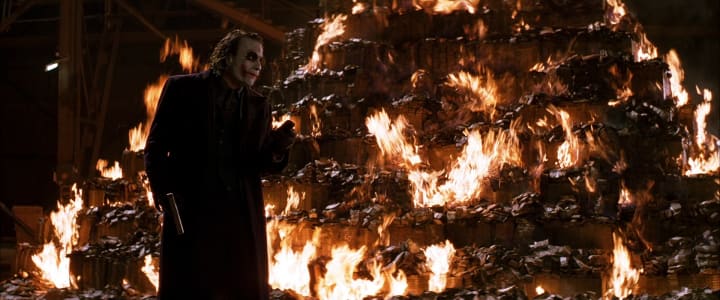
The Joker has no origin in this film. His disfigurement is not caused by falling into a vat of chemicals. His permanent grin is a Glasgow smile and his bleached skin is now white make-up, functioning as sweaty warpaint. In fact, he gives two different origins for his scars. The Joker has a sense of humor, using comedy as a way to comment on the absurdity of the established order. He’s an agent of chaos causing anarchy, obsessing over Batman, Gotham’s symbol of order. The Joker robs banks, takes over Gotham’s underworld, causes chaos in Gotham by threatening to blow up a hospital, a Gotham City ferry, and a prison barge. He murders cops, judges, and the woman Batman loves, Rachel Dawes. This broke the rules. Before that, you never killed the superhero’s love interest. In this movie he fully carries out what his comic book counterpart attempted to do in The Killing Joke: He causes Harvey Dent, Gotham City’s District Attorney, to abandon his moral code after his disfigurement, transforming him into the villain, Two-Face.
“You see, madness is like gravity. All you need is a little push.”

This is the best depiction of Batman and The Joker’s relationship in a live-action film, their yin-yang relationship is the film’s highlight. The Joker tries hard to get Batman to break his no-kill rule. Batman even considers it. In the last scene Batman and The Joker have together, Joker says, “I won’t kill you because you’re just too much fun…I think you and I are destined to do this forever.” When all is done, The Joker is able to do something he wasn’t able to accomplish in the 1989 film: Win the battle for Gotham’s soul.
Heath Ledger’s unpredictable performance, complete with facial tics and a voice that switches octaves from one sentence to the next, won him a posthumous Academy Award for Best Supporting Actor.
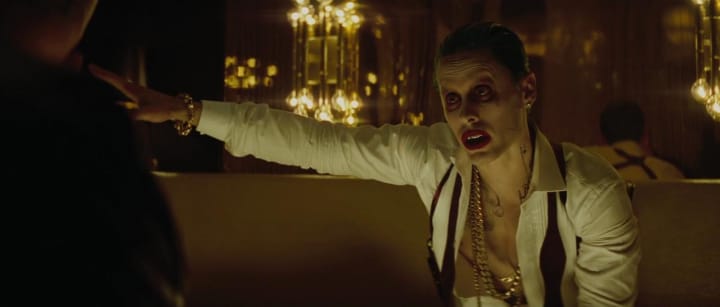
Joker the Gangster
Jared Leto, fresh off his Academy Award for 2013’s Dallas Buyer’s Club, was cast in David Ayer’s Suicide Squad released in 2016. Leto is known for his intense method acting. Leto took a similar approach to Ledger; isolating himself and ingesting a variety of different influences. He researched shamanism. He felt The Joker may be “much older than people think,” so he listened to gospel music from the 1920s. Director, David Ayer, felt Joker should look more like a modern gangster and gave the character grills and covered him in tattoos. This wasn’t your daddy’s Joker.
Leto said, “I took a pretty deep dive. But this was a unique opportunity and I couldn’t imagine doing it another way. It was fun, playing these psychological games. But at the same time, it was very painful.” These psychological games included Leto hiring a “henchman” to drop a dead pig on the rehearsal room table, sending his co-stars “Joker gifts” like used condoms and anal beads. He sent Will Smith bullets and Margot Robbie a rat (which she kept because that’s what her character, Harley Quinn would do). He never broke character. Leto’s goal was to freak everyone out and inspire chaos on set. He has since backpedaled on these rumors even though all these stories were confirmed by the cast members.
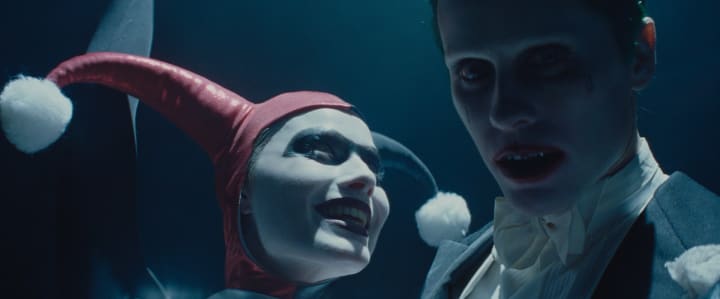
Before the events of the film and Batman v. Superman, Leto’s Joker murdered Robin and tortured his Arkham Asylum psychiatrist, Harleen Quinzell, into insanity (This is the first live-action appearance of the Joker’s abused girlfriend, Harley Quinn, a popular character introduced in the animated series.) The depiction of these characters’ twisted romance was highly anticipated by fans. Unfortunately, this isn’t explored. When Harley Quinn is arrested, The Joker is heartbroken and searches for her so he can break her out of prison. This interpretation is not faithful to their origins. In the source material, The Joker physically and mentally abuses Harley. Whenever she is arrested, the only time he misses her is when she is not present to do his bidding. He is not capable of love. He views Harley as a possession, a tool to fulfill his agenda, either as a second in command or a punching bag. There have been reports that there are scenes depicting their relationship on the cutting room floor.
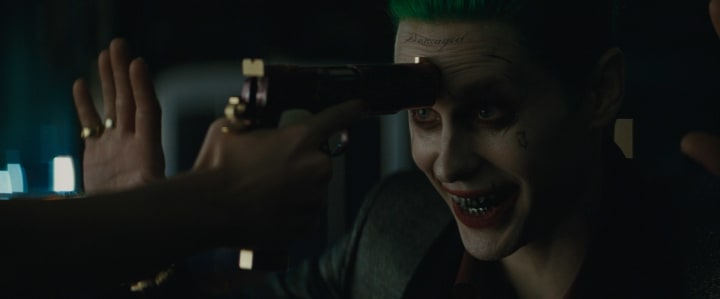
As for Jared Leto’s performance, let’s just say it definitely had people talking. Critics found his performance intriguing. Others felt he couldn’t reach the heights of Nicholson and Ledger. Comic book fans thought, “What the fuck is this?” Me included. His performance is very out there. Not out there like Heath Ledger’s performance. It’s just…out there. It’s tough to see what he’s going for. Even though Ledger’s was odd, there was a method to the madness and that’s why audiences responded to it.
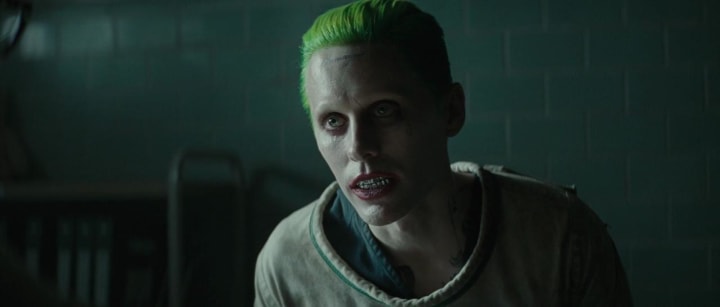
Supposedly, a lot of footage was cut but Leto’s performance is all over the place. He’s wacky for the sake of being wacky. He has a tattoo of a smiling face on his hand that he puts over his mouth when he laughs. He growls like a panther.
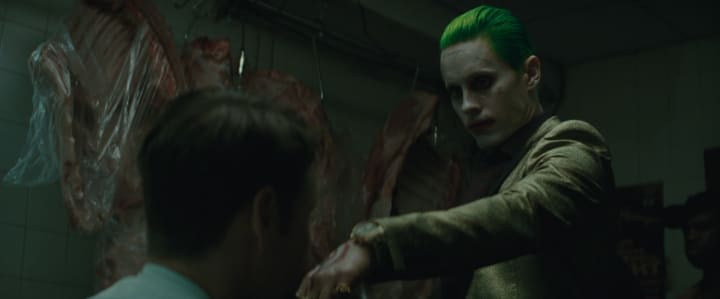
His line delivery is over-the-top. Then..there’s his Joker laugh. It’s very difficult to see what he’s going for. Leto tried hard. Too hard. He’s wacky cause The Joker is wacky. The shamanism, the gospel music, the “Joker gifts” don’t bring any clarity. Let’s hope we get to see the David Ayer cut one day and see all of Leto’s work because right now, The Joker in Suicide Squad is…a joke.
Ha. Ha. Ha.

Joker the Comedian
Todd Phillips, the director of comedies like Old School, The Hangover, and his masterpiece, Starsky & Hutch recently switched to directing dramas. At a screening of his film, Road Dogs, he left the theater and smoked a cigarette; a tradition for him since he has trouble watching his films. He thought about the state of Hollywood and the films he wanted to make and he looked at a billboard across the street. It was promoting the latest comic book film. He thought to himself if anyone wanted to make a successful movie they’d have to feature “one of those guys,” meaning a superhero. Then, a lightbulb switched on in his head. In order for him to make the films he wanted to make, he’d make a comic book adaptation. Not just any adaptation, a grounded comic book film; one that would flip the genre on its head.
Phillips pitched the film to Warner Bros. and convinced them to do standalone films outside their cinematic universe. Warner Bros. greenlit the film; angering the current Joker actor, Jared Leto. Warner Bros. wanted DiCaprio but Phillips got his number one choice, hot boy, Joaquin Phoenix, considered one of the finest actors of his generation and known for his wild acting style, making his performance as the film’s protagonist, Arthur Fleck extremely unpredictable.
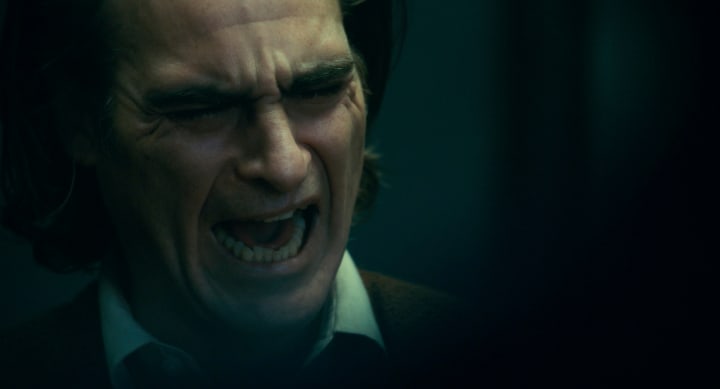
Joaquin plays Arthur Fleck, a clown and stand-up comedian in 1981 Gotham City. He doesn’t have the best luck. He has a condition that causes him uncontrollable laughter. The film opens with Arthur getting jumped by a bunch of Puerto Ricans from The Bronx. Gotham. I mean Gotham. As a Puerto Rican from The Bronx, I’m probably projecting something.

Anyway, he’s seeing a psychiatrist, he struggles to take care of his sick mother, and make ends meet. When Arthur is fired from his clown job, he’s attacked by businessmen on the train and he takes out his piece and lights them up. Then he runs to a bathroom and dances. This event starts a class war in Gotham with clown masks becoming a symbol for the poor. From that point on, things start escalating. He starts a relationship with his neighbor, Sophie (Zazie Beetz). He gets cut off from his therapy and medication. He discovers he might be the illegitimate son of a billionaire, Thomas Wayne (Bruce Wayne’s father). Then we realize his relationship with Sophie is a delusion. He murders his clown friend and dances on some stairs in The Bronx. I mean Gotham.

He appears as a guest on the late-night Murray Franklin Show, where he talks about the hideous flaws of society, shoots Murray in the head and he’s celebrated by the protestors in the demonstration outside, where Thomas and Martha Wayne are murdered in front of their son, Bruce.
Warner Bros. was understandably very nervous about this portrayal of The Joker. After all, this was a character whose face was on pajamas at Target but they had nothing to worry about because the film grossed $1 billion and won Joaquin his first Oscar (Good for you, Joaquin). Some called it the best comic book adaptation since The Dark Knight. The film was not without its controversy. There was concern the film would inspire violence; a controversy that was applied to one of its influences, Martin Scorsese’s Taxi Driver. In fact, this film is heavily inspired by Scorsese films from the 70s and 80s, such as The King of Comedy, in terms of story, character, and aesthetic. Phillips even cast Robert De Niro as Murray Franklin. It even takes cues from another film inspired by Taxi Driver, You Were Never Really Here, also starring Joaquin.


The film isn’t an adaptation of a comic book per se but it has its references to The Killing Joke and The Dark Knight Returns. Arthur is a failing comedian similar to The Joker in The Killing Joke and the late-night talk show scene at the end references The Dark Knight Returns where The Joker also commits murder. Phillips said this is a different interpretation of The Joker but Arthur doesn’t have much in common with The Joker other than those two scenes. He wears the traditional Joker costume at the end but does this make him The Joker? Arthur is very disturbed but he’s not very smart. The Joker is an evil genius. The audience has to make a giant leap to believe in twenty years, he’d match wits with Batman, a detective with genius intellect. Now, if this were a film that didn’t take place in Gotham City. If the billionaire in the film wasn’t Thomas Wayne, and if Arthur didn’t dress up in the costume, the film wouldn’t have gotten the recognition that it received. Phillips made a weird comic book film that made $1 billion dollars without a CG battle at the end. That’s a big victory for character studies. Phillips finessed the game and made the Martin Scorsese film he always wanted to make.
What is the enduring appeal of The Joker? The character has endured for eight decades in some shape or form, balancing a variety of different tones and entertaining audiences of all ages. He’s funny to toddlers and to some disturbed young men, he’s a role model. The Joker is a metaphor for anything that terrifies us.
The Last Laugh
What is the enduring appeal of The Joker? The character has endured for eight decades in some shape or form, balancing a variety of different tones and entertaining audiences of all ages. He’s funny to toddlers and to some disturbed young men, he’s a role model. The Joker is a metaphor for anything that terrifies us.
The appeal of Batman is that he’s a revenge fantasy. He kicks the shit out of goons in order to cathartically deal with his pain. Everyone can relate to that on some level. Not The Joker. As Batman says in the comics, “He’s not crazy, he’s just evil.” The Joker represents the evil of the world. He shows us our fantasy is a joke and he’s laughing in our face.

About the Creator
George A. Velez
When I'm not directing and writing movies, I write ABOUT them. I talk about them. Sometimes I eat them.
I like movies is what I'm trying to say.
Website: georgeavelez.com





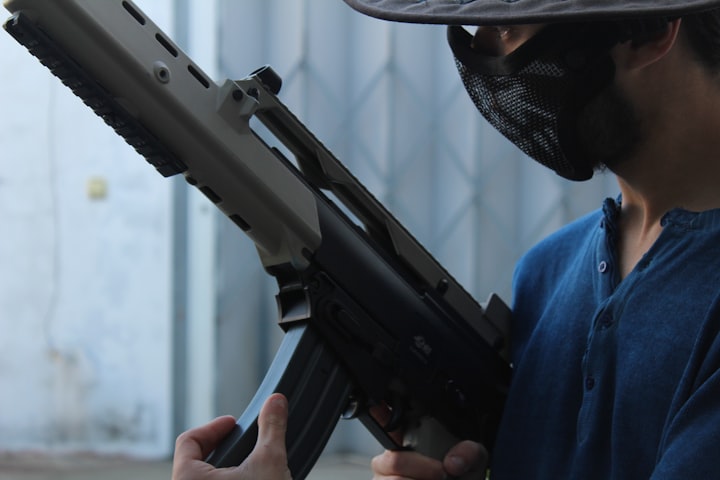

Comments
There are no comments for this story
Be the first to respond and start the conversation.